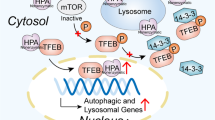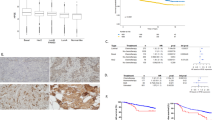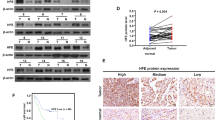Abstract
The remodeling of extracellular matrix (ECM) is an important process required for cancer cells to turn into invasive and metastatic cancer cells. To dissolve the protein components of ECM, matrix metalloproteinases are some of the essential enzymes. Another ECM remodeling enzyme is the heparanase (Hpa) that digests the heparin sulfate component of the matrix. In metastatic cancer cells the Hpa gene is upregulated. To investigate the mechanism of why Hpa was upregulated in metastatic cancer cells, the regulatory sequence of heparanase gene was isolated and its function analysed in metastatic breast cancer cells. We found there are four ETS transcription factor binding sites. Two of them flanking the transcription initiation of the Hpa gene are nonfunctional, whereas two others are highly functional and responded to exogenously added ETS transcription factors. Mutation of these two ETS binding sites abolished the transcriptional activation of Hpa promoter by ETS transcription factors. Among four transcription factors tested (ETS1, ETS2, PEA3, and ER81), ETS1 and ETS2 are more potent in transactivating the human Hpa gene. Furthermore, dominant-negative ETS transcription factors failed to transactivate Hpa promoter and could abrogate the function of wild-type transcription factor in transactivation activity of ETS transcription factors on the Hpa promoter. These results suggest that ETS transcription factors play an important role in tumor invasion and metastasis by modulating the remodeling of ECM.
This is a preview of subscription content, access via your institution
Access options
Subscribe to this journal
Receive 50 print issues and online access
$259.00 per year
only $5.18 per issue
Buy this article
- Purchase on SpringerLink
- Instant access to full article PDF
Prices may be subject to local taxes which are calculated during checkout




Similar content being viewed by others
References
Arias AM . (2001). Cell 105, 425–431.
Buttice G and Kurkinen M . (1993). J. Biol. Chem., 268, 7196–7204.
Carmeliet P and Jain RK . (2000). Nature, 407, 249–257.
Chen JH, Vercamer C, Li Z, Paulin D, Vandenbunder B and Stehelin D . (1996). Oncogene, 13, 1667–1675.
Dempsey LA, Brunn GJ and Platt JL . (2000). Trends Biochem. Sci., 25, 349–351.
Dong J, Kukula AK, Toyoshima M and Nakajima M . (2000). Gene, 253, 171–178.
Eccles SA . (1999). Nat. Med., 5, 735–736.
Folkman J . (1997). In Cancer Med. (J.F. Holland et al. eds. Williams and Wilkins, Baltimore, MD), 181–204.
Freeman C and Parish CR . (1998). Biochem. J., 330, 1341–1350.
Hanahan D and Weinberg RA . (2000). Cell, 100, 57–70.
Higashino F, Yoshida K, Noumi T, Seiki M and Fujinaga K . (1995). Oncogene, 10, 1461–1463.
Hiroumi H, Dosaka-Akita H, Yoshida K, Shindoh M, Ohbuchi T, Fujunaga K and Nishimura M . (2001). Int. J. Cancer, 3, 786–791.
Hoogewerf AJ, Leone JW, Reardon IM, Howe WJ, Asa D, Heinrikson RL and Ledbetter SR . (1995). J. Biol. Chem., 270, 3268–3277.
Hulett MD, Freeman C, Hamdorf BJ, Baker RT, Harris MJ and Parish CR . (1999). Nat. Med., 5, 803–809.
Jiang P, Kumar A, Parrillo JE, Dempsey LA, Platt JL, Prinz RA and Xu X . (2002). J. Biol. Chem., 277, 8989–8998.
Kohn EC and Liotta L . (1995). Cancer Res., 55, 1856–1862.
Nicolson GL . (1993). Cancer Metastasis Rev., 12, 325–343.
Vlodavsky I, Friedmann Y, Elkin M, Aingorn R, Ishai-Michaeli R, Bitan M, Pappo O, Perez T, Michal I, Spector L and Pecker I . (1999). Nat. Med., 5, 793–802.
Werb Z . (1997). Cell, 91, 439–442.
Acknowledgements
We thank Ms KJ Chen for her technical assistance. This study was supported by National Science Council Grants no. NSC90-2318-B-320-003-M51 and no. NSC88-2314-B-320-009, and Tzu Chi Foundation.
Author information
Authors and Affiliations
Corresponding author
Rights and permissions
About this article
Cite this article
Lu, W., Liu, Y., Kang, B. et al. Trans-activation of heparanase promoter by ETS transcription factors. Oncogene 22, 919–923 (2003). https://doi.org/10.1038/sj.onc.1206201
Received:
Revised:
Accepted:
Published:
Issue date:
DOI: https://doi.org/10.1038/sj.onc.1206201
Keywords
This article is cited by
-
Heparanase: roles in cell survival, extracellular matrix remodelling and the development of kidney disease
Nature Reviews Nephrology (2017)
-
Activation of endothelial NAD(P)H oxidase accelerates early glomerular injury in diabetic mice
Laboratory Investigation (2016)
-
miRNA-558 promotes gastric cancer progression through attenuating Smad4-mediated repression of heparanase expression
Cell Death & Disease (2016)
-
Smad4 suppresses the tumorigenesis and aggressiveness of neuroblastoma through repressing the expression of heparanase
Scientific Reports (2016)
-
Heparanase promotes tumor infiltration and antitumor activity of CAR-redirected T lymphocytes
Nature Medicine (2015)



